Easy Half Square Triangles Tutorial (VIDEO!)
Beginner and advanced quilty friends alike, I simply love that we all share one common thing — an appreciation for half square triangles! You can make hundreds of different quilts using just the simple HST. This half square triangles tutorial includes a conversion chart and instructions on how to make this wonderful quilt block three different ways. Oh! Plus a very early-days video tutorial I know you'll enjoy.
Comprised of simply a square made from two equal right triangles, this block is one of the most used and most versatile quilt blocks in history. Using the instructions below you will learn to make two at a time, four at a time, or eight at a time!
As a quilt designer, I find myself continually going back to half square triangles. It is a foundational block to some of the most famous quilts hanging in museums as well as simple baby quilts you find on Etsy. This quilt block is easy enough for beginners, but can be turned, rotated, resized and remade in so many ways, it remains complex and stimulating enough for advanced quilters.
Half Square Triangles Tutorial: Cheat Sheet

Half Square Triangles Video Tutorial: Make 8 HSTs at Once!
*Note: In the video I mention that a 5 ½" square makes 8 unfinished 2 ½" HSTs. Since then, I have changed the math so that there is a little more wiggle room in the sewing and cutting. According to the chart below (which I recommend using) a 5 ¾" square will produce 8 unfinished 2 ½" HSTs.
You May Also Like...
Check out the HST conversion charts below for three different ways of making half square triangles! Bookmark this half square triangles tutorial so you can come back to it.
Trending patterns!
3 Different Half Square Triangle Techniques
The amount of HSTs you need and the size of fabric you are using will determine which of these three techniques you should choose. Based on what a quilt pattern dictates, sometimes even within the same quilt you can use all three techniques!
The Basic: 2-at-a-time half square triangles
I recommend using this basic 2-at-a-time HST method if you only need to make a small amount of HSTs OR if you are working with scraps or small cuts of fabric. I say this because this method allows you to use fabric this is only slightly larger than your finished HSTs.
- Cut two squares of contrasting fabric (we’ll say a light and a dark).
- Place right sides together and draw a guideline from corner to corner on the diagonal.
- Sew a 1/4" seam on both sides from the guideline.
- Cut along the guideline, press the seam and trim the dog ears.
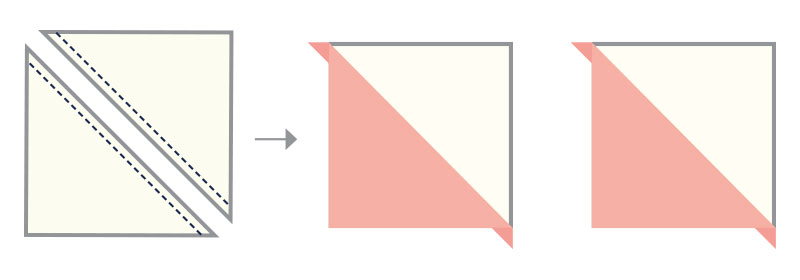
2-at-a-time Half Square Triangle Conversion Chart
Add 7/8" to the finished size you want. The fraction 7/8" translates to 0.875. In all honesty, I hate weird little fractions like this, so I like to round up. For example, if I want a 6" finished HST, I'll cut my squares 7".
Finished HST | Cut Squares | Finished HST | Cut Squares |
|---|---|---|---|
2" | 2 ⅞" | 5" | 5 ⅞" |
2 ½" | 3 ⅜" | 5 ½" | 6 ⅜" |
3" | 3 ⅞" | 6" | 6 ⅞" |
3 ½" | 4 ⅜" | 6 ½" | 7 ⅜" |
4" | 4 ⅞" | 7" | 7 ⅞" |
4 ½" | 5 ⅜" | 7 ½" | 8 ⅜" |
The Quad: 4-at-a-time half square triangles
This is a very popular way of making HSTs because it allows you to make your blocks in a large variety of fabrics while still being efficient. The one reason some quilters don't like this 4-at-a-time method is because once you trim your blocks all four sides are bias cuts. That means these blocks can be stretchy and easier to distort.
When using this method you can counteract the stretch by starching your fabric before cutting.
- Layer one light and one dark square, right sides together.
- Pin squares in place.
- Sew a 1/4" seam continually around the entire square, pivoting at the corners.
- Cut the square twice from corner to corner diagonally.
- Press the seams and trim the dog ears.
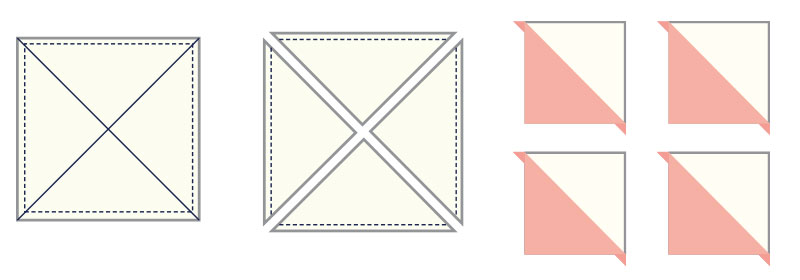
4-at-a-time Half Square Triangle Conversion Chart
This math is more complex and will sometimes end up with an odd decimal. The chart below rounds the decimal up to the nearest fraction. Trim the half square triangles once they are sewn and pressed. To figure out the math, divide the unfinished HST size by 0.64. (So for example, if you need a 3" finished HST, your unfinished HST will be 3 1/2".)
As I mentioned previously, I like to round when cutting. So for example, if I need a 6" unfinished HST, I'll cut either 9 1/4 or 9 1/2". Both would work since I will be trimming the HST down in the end no matter what.
unfinished HST | Cut Squares | unfinished HST | Cut Squares |
|---|---|---|---|
2 ½" | 4" | 5 ½" | 8 ¾" |
3" | 4 ¾" | 6" | 9 ⅜" |
3 ½" | 5 ½" | 6 ½" | 10" |
4" | 6 ¼" | 7" | 11" |
4 ½" | 7" | 7 ½" | 11 ¾" |
5" | 7 ¾" | 8" | 12 ½" |
The Octo-Awesome: 8-at-a-time half square triangles
This method is the fastest, however it does require the largest cuts of fabric. That may hinder you using precuts like fat quarters or layer cakes. If you were already planning on using yardage and just need a lot of HSTs in the same fabric, this is my recommended method. Just don't go so fast you cut off a finger. Been there, done that, and it ain't fun! 😉
- On your light square, draw two lines diagonally, one horizontally and one vertically.
- Place one light square on top of one dark square, right sides together. Sew a ¼” from the guidelines.
- Cut along guidelines.
- Press seams toward the dark fabric and trim dog ears.
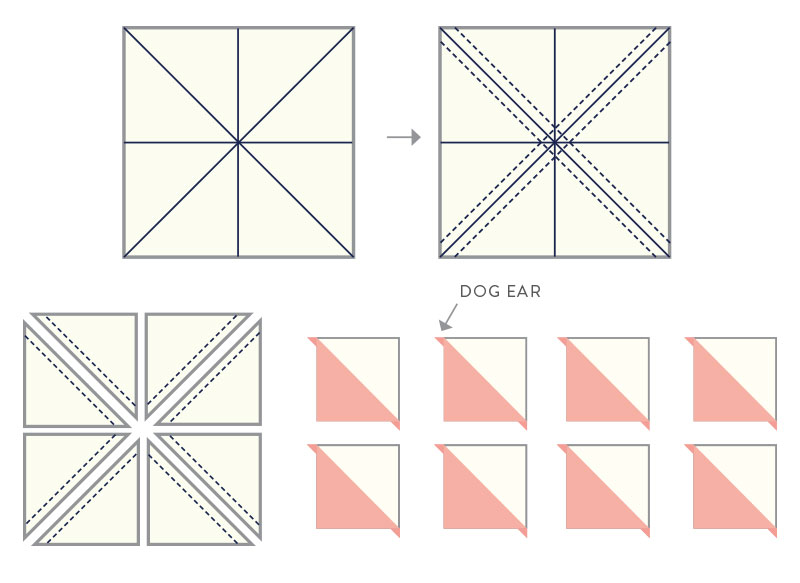
The Octo-Awesome Math Shortcut
Add ⅞" to the finished size and double it. (Lately I've been rounding these measurements up to give myself some more wiggle room. You end up trimming all of your HSTs down afterwards, but your blocks are very accurate. eg. rather than cutting 5 ¾" squares to make 2" finished HSTs, I'll cut 6" squares. Make sense?)
Finished HST | Cut Squares | Finished HST | Cut Squares |
|---|---|---|---|
2" | 5 ¾" | 5" | 11 ¾" |
2 ½" | 6 ¾" | 5 ½" | 12 ¾" |
3" | 7 ¾" | 6 | 13 ¾" |
3 ½" | 8 ¾" | 6 ½" | 14 ¾" |
4" | 9 ¾" | 7" | 15 ¾" |
4 ½" | 10 ¾" | 7 ½" | 16 ¾" |
Beginner-Friendly Half Square Triangle Patterns
If you're a new quilter looking to try out HSTs for the first time, start with these patterns! For patterns designed at a moderate difficulty level, keep reading.
Triangle Jitters is one of my first cracks at designing a quilt. As a newbie, and being very intimidated by the prospect of going off-book, I thought it would be best to limit my color palette. I also decided that sticking with one block would make the math portion of writing a quilt pattern much easier.
If you are interested in designing your own HST quilt, limiting the colors and even more specifically limiting the fabric to just solids are two great ways to ensure success. By simply rotating HSTs, I formed diamonds, lines and larger overall patterns. And by limiting the colors, this quilt is able to achieve a sleek, modern look.
For a more minimal look, check out our two-color Triangle Jitters tutorial. Or for a scrappier and more colorful version, use our fat quarter-friendly eight-color Triangle Jitters tutorial!
Nordic Triangles is a classic for a good reason. This pattern uses the Octo-Awesome technique for creating the HSTs, so it's a very economical use of fabric. Because of the intricate way these triangles are varied throughout the pattern, this quilt can look vastly different based on the fabrics and amount of colors you choose. It also looks elegant in solids and fun in prints.
For the fat quarter-friendly version shown above, check out our ombré Nordic Triangles tutorial!
Summer Haze is a fun, scrappy, and fast quilt made entirely of HSTs and solid squares and rectangles. These simple shapes come together to make oversized diamonds that give the quilt its unique look!
Named after that haze late summer/early fall time, when sunsets are at the most beautiful and the leaves on the trees are just hinting at change, Summer Haze looks best with a wide variety of colors.
For even more tips on making HSTs, don't miss our three-part Summer Haze Tips & Tricks series!
The Rocksteady quilt pattern is the perfect example of how versitile half square triangles can be. This entire quilt is made using just one size of HST plus some solid squares!
If you're new to making half square triangles, this pattern is great for you because we have two excellent small tutorials to help build your HST confidence before jumping into the full-sized quilt. Our quilted Rocksteady table runner is a sophisticated addition to any home, and our Rocksteady Christmas stocking is one of the most popular Suzy Quilts tutorials ever!
Stars Hollow uses HSTs to create a fun combination of two quilt blocks — a Sawtooth Star and a Pinwheel. And in this pattern, you don't only get to practice your HSTs, you'll also make Flying Geese! Adding more blocks to your quilting tool box is particularly helpful for beginner quilters looking to grow into more advanced patterns.
If you are more of a neutrals fan, don't miss our tips for making a neutral Stars Hollow quilt!
Fly Away was one of my very first quilt patterns! If you're feeling bold, read the dramatic story of this design here, but be ready to ride a roller coaster of emotions.
HSTs are a classic but simple block. They're timeless. They can transform into new shapes, and playing with them can open new design doors. But sometimes, highlighting repeating HSTs can be both striking and soothing. These high-contrast HSTs, with tiny pops of color, are the perfect example.
And if you're looking for the perfect baby shower gift, try making a baby Fly Away quilt with a matching Fly Away bib!
Who doesn't love a mosaic? Found all over the world, mosaics are typically made from glass or tile. If you've ever wanted to snuggle up under a mosaic without being poked by hundreds of pieces of glass, this pattern is for you! There's even a video tutorial showing how to make the top and bottom triangle rows!
Moderate Skill Level Half Square Triangle Patterns
These patterns use HSTs in their construction, but also have more advanced piecing techniques. But don't worry, I'll walk you through what makes each of these patterns slightly more challenging!
Here's what I love about a pattern like Gather — it looks way harder than it is! This quilt has alternating HSTs at an angle that come to a point at the top, and that makes it seem like each HST has to be sewn on point. Nope! This quilt is made up of rows of HSTs and long strips of sashing fabric. That's it!
The hardest part of Gather is trimming. That's why Gather is listed as a moderate skill level pattern — it does have one hard part. I cover that and so much more in the Gather quilt sew along, including a video all about trimming!
The Voyage quilt gets its completely unique look by combining HSTs with a similar block — half rectangle triangles. HRTs are a little harder to make, so Voyage is listed as a moderately difficult pattern. Our seven-part Voyage quilt sew along that covers tips for HSTs and HRTs. After reading our sew along tips and making your first Voyage quilt, you'll be a pro at both blocks in no time!
New Horizons is a little more challenging for two reasons. First, the HSTs in this pattern have three colors instead of two. You'll be making your HSTs with strips of fabric pieced together! This adds another step to your HST process.
The other block used in New Horizons is called a stitch-and-flip block. So, like with Voyage, you'll be learning two new blocks in one pattern!
Holiday Party is made with HSTs, a template, and very precise cutting. That may sound intimidating, but we make it super easy in our Holiday Party quilt sew along!
For this quilt, we recommend making one full block before moving on and chain piecing each, especially if you are a beginner. That way, you'll be sure to understand each step of how the block comes together right away!
Ask Us Your Half Square Triangle Questions!
Do you have a question about making half square triangles? Or about one of our half square triangle patterns? Let us know in the comments and tell us which is your favorite technique in this half square triangles tutorial!
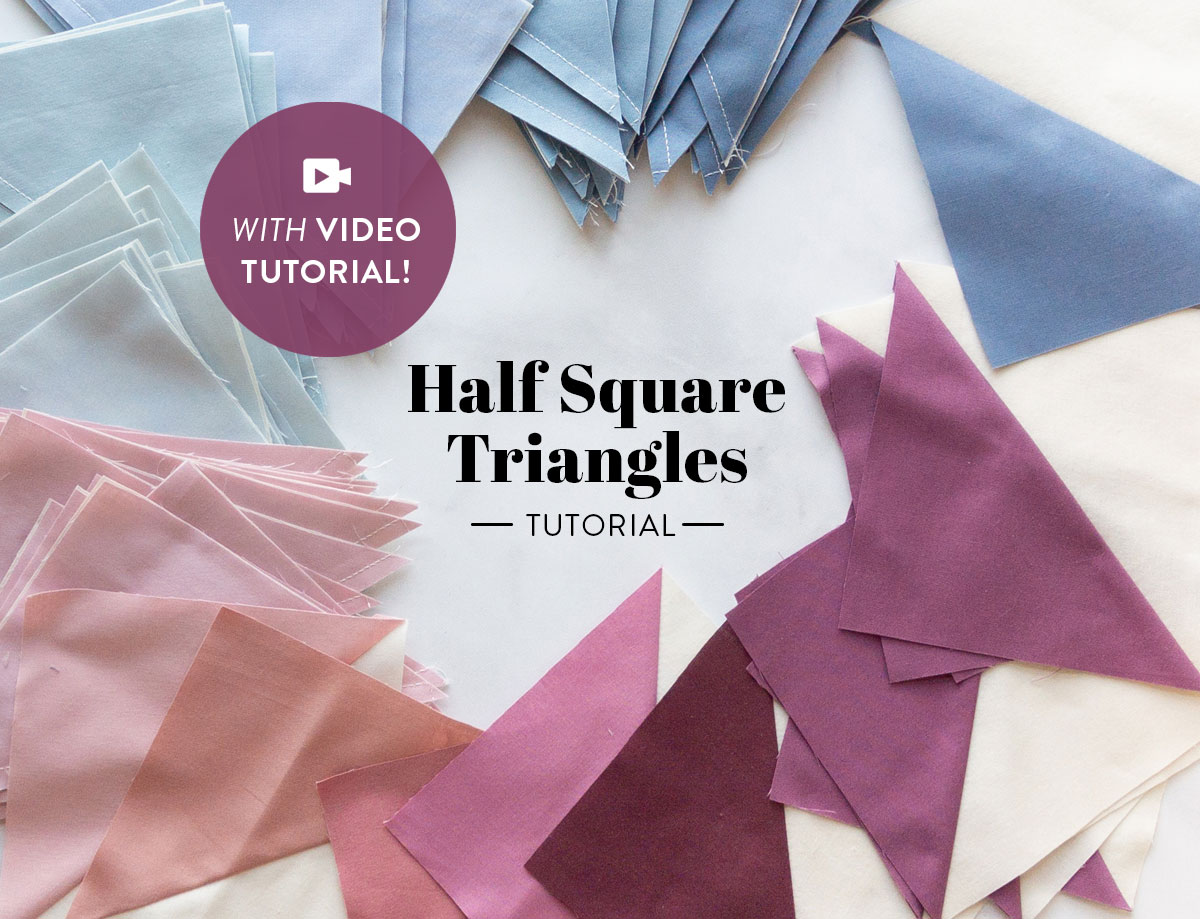
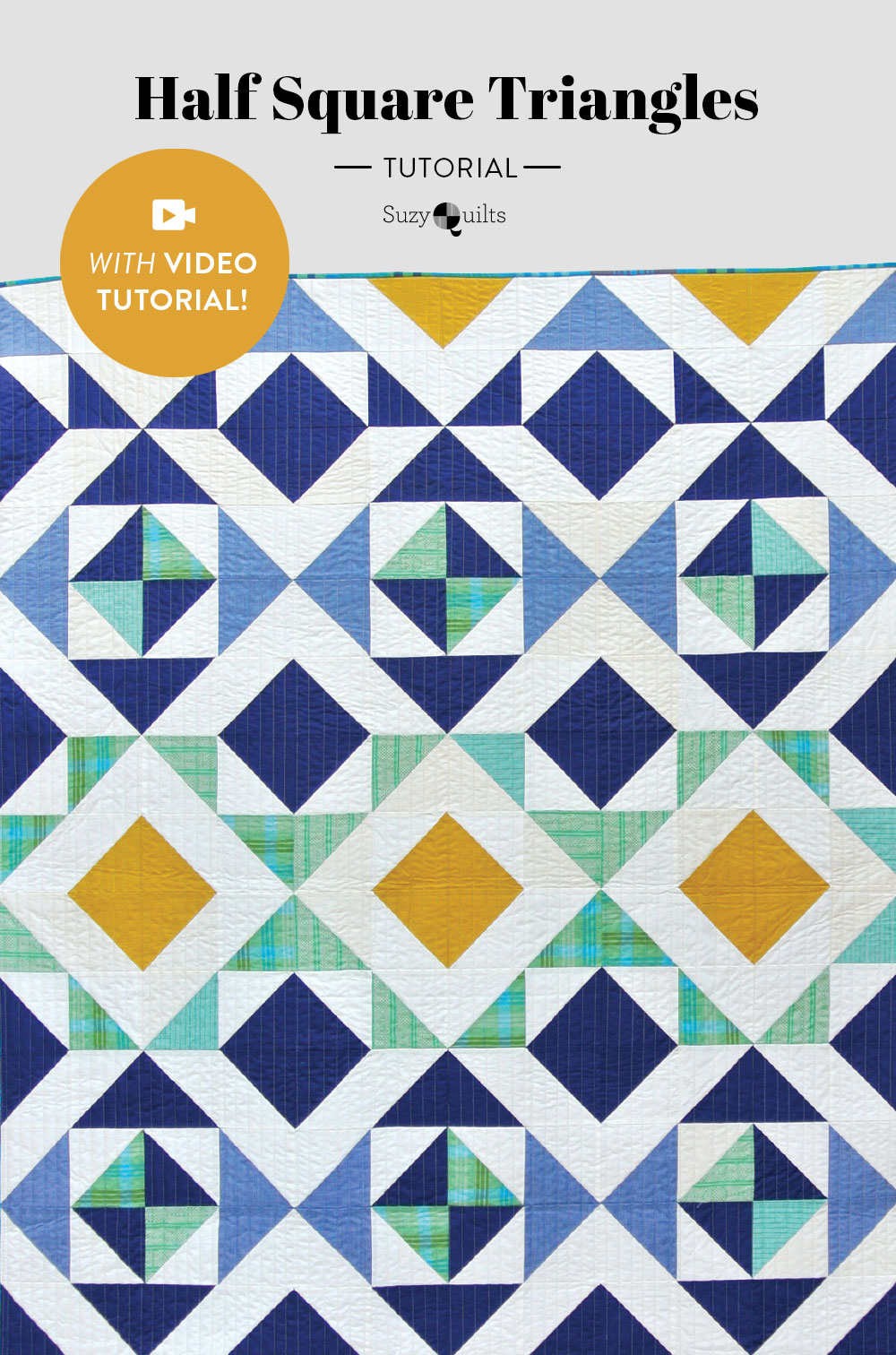
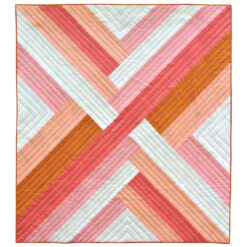
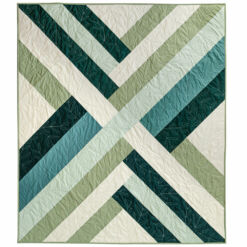
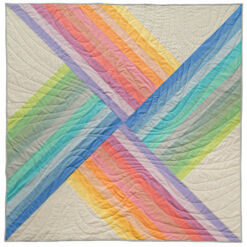
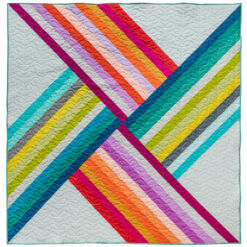
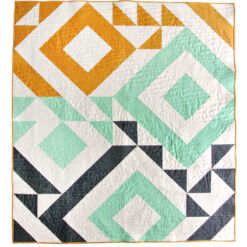
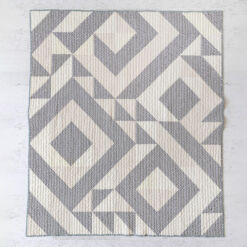
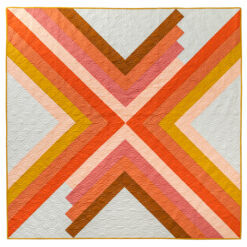
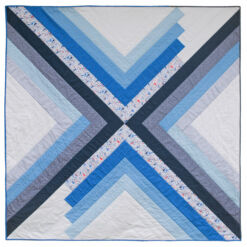
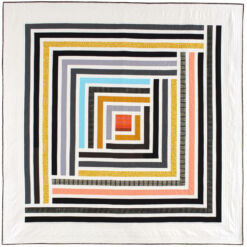
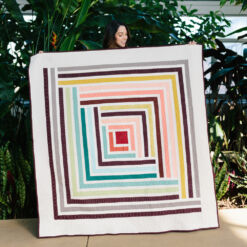
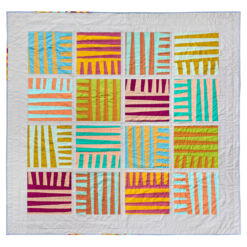
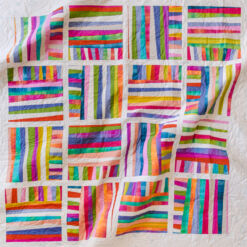
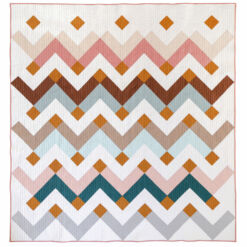
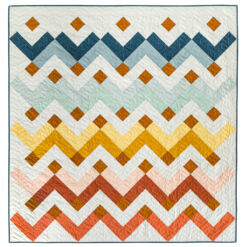
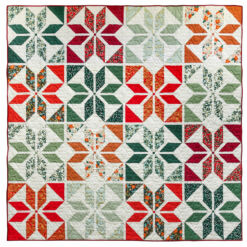
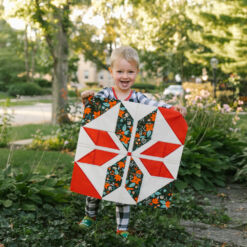
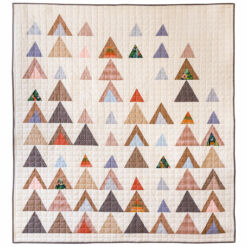
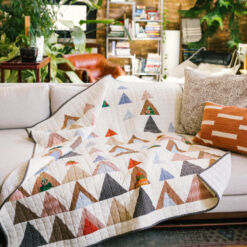
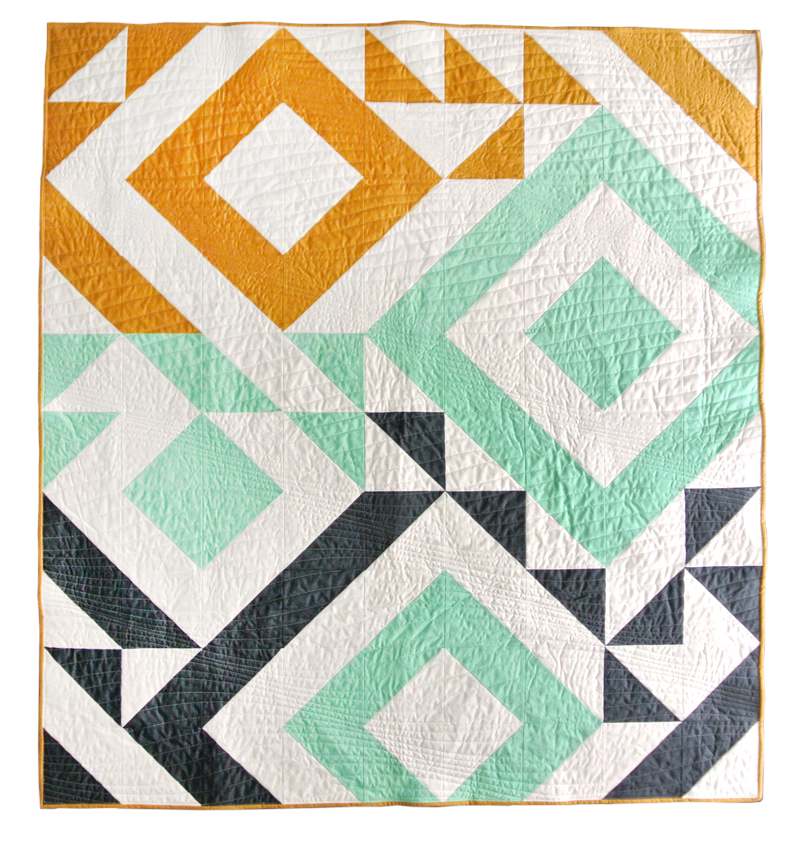

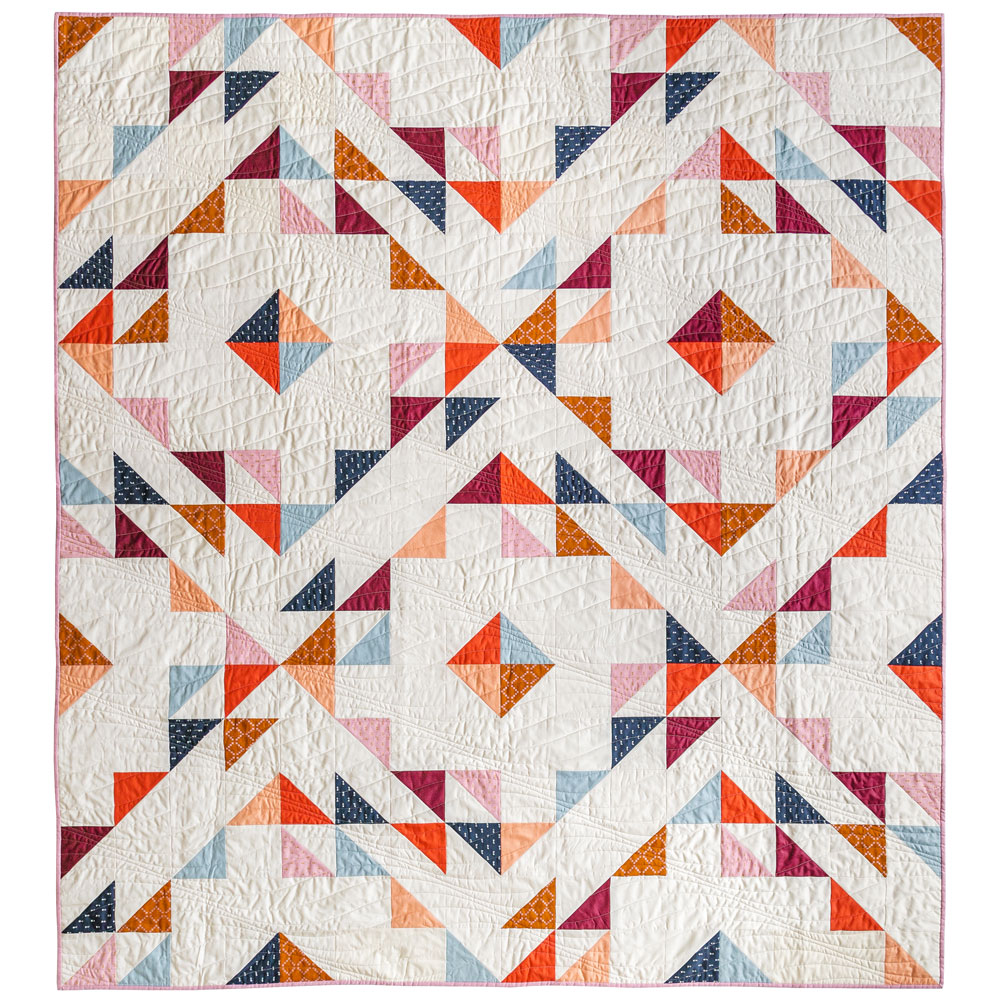
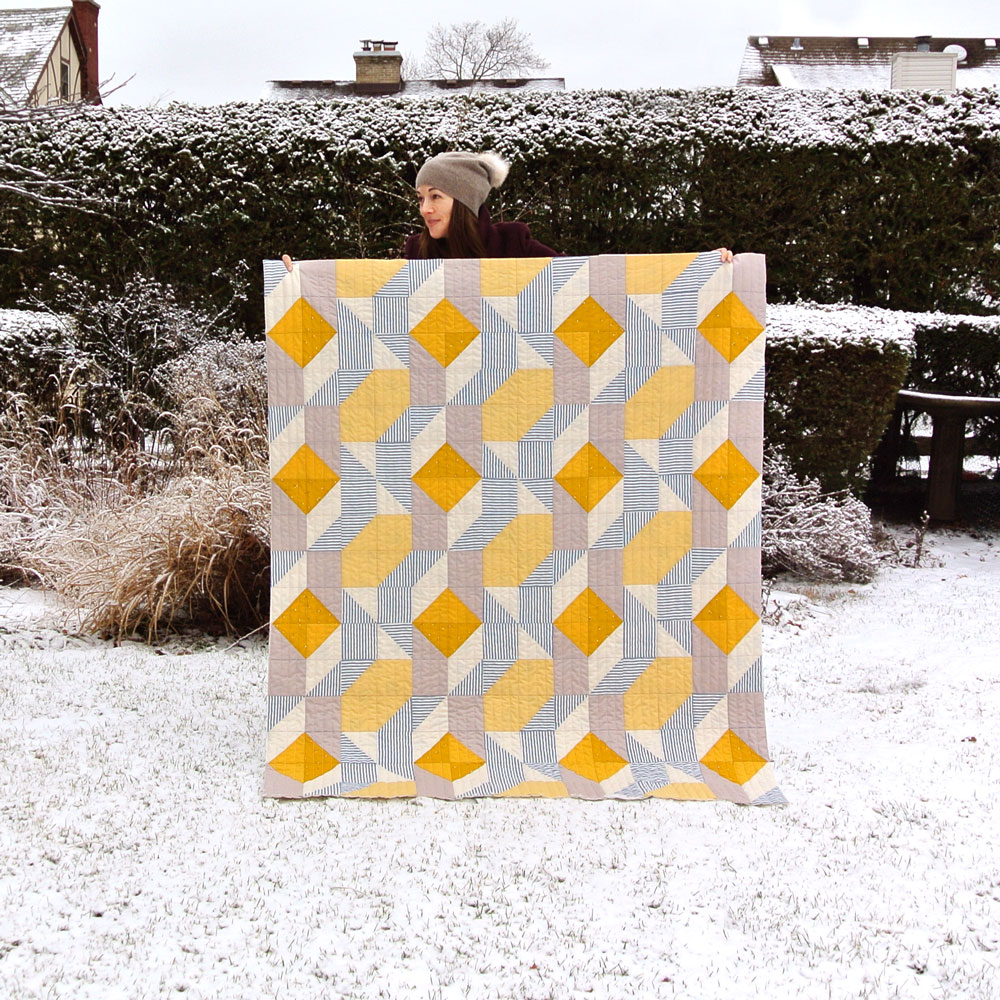
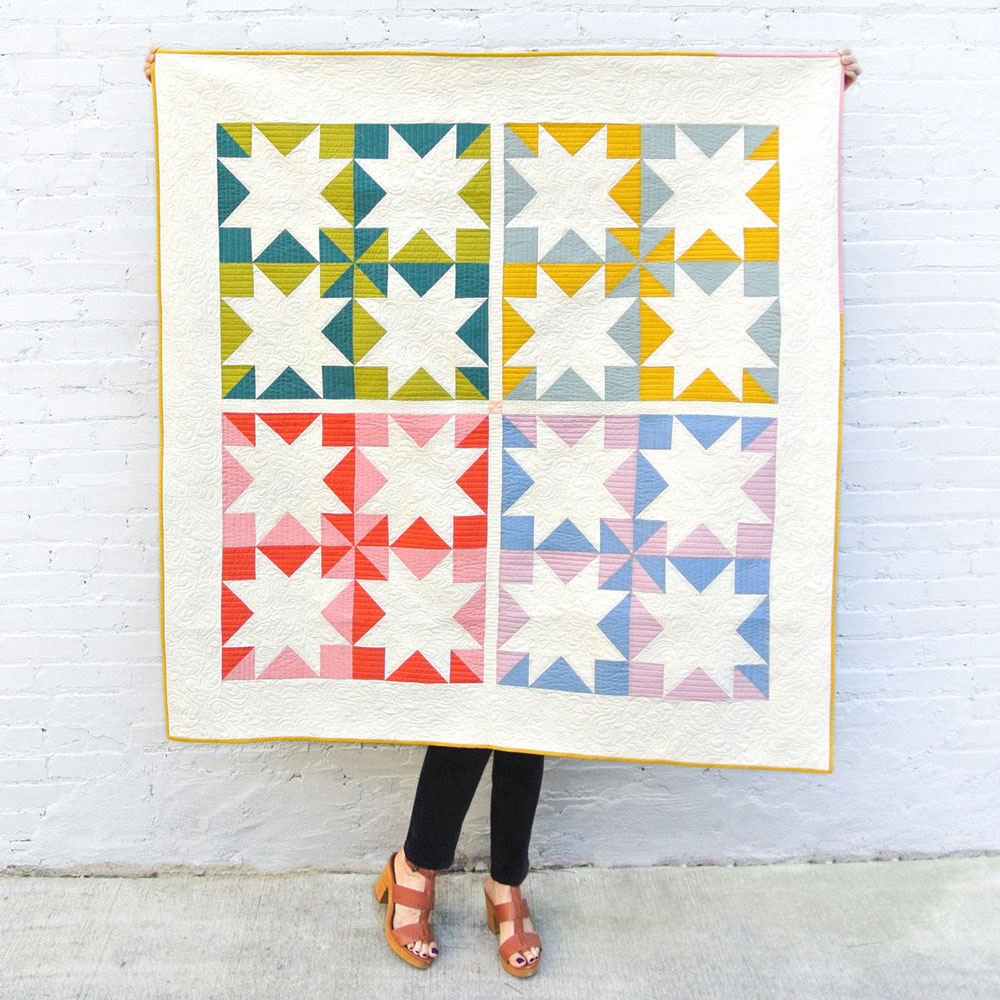
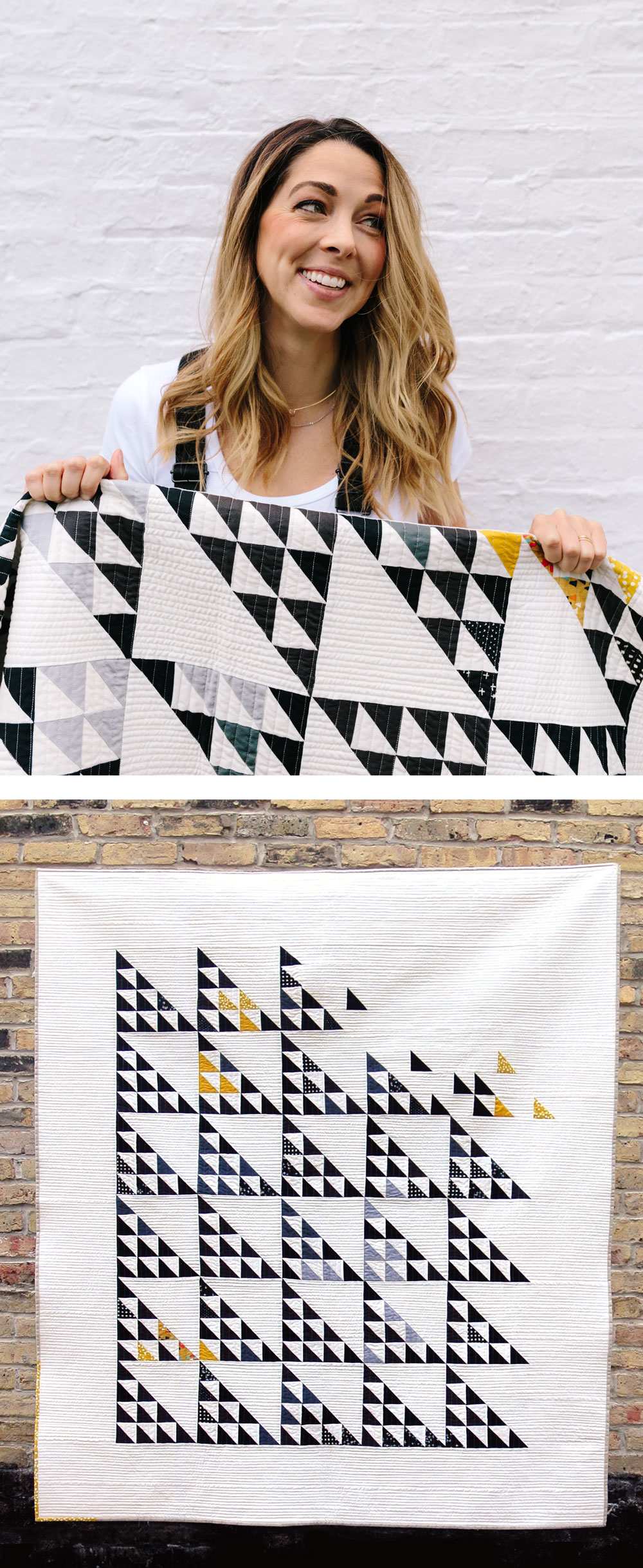
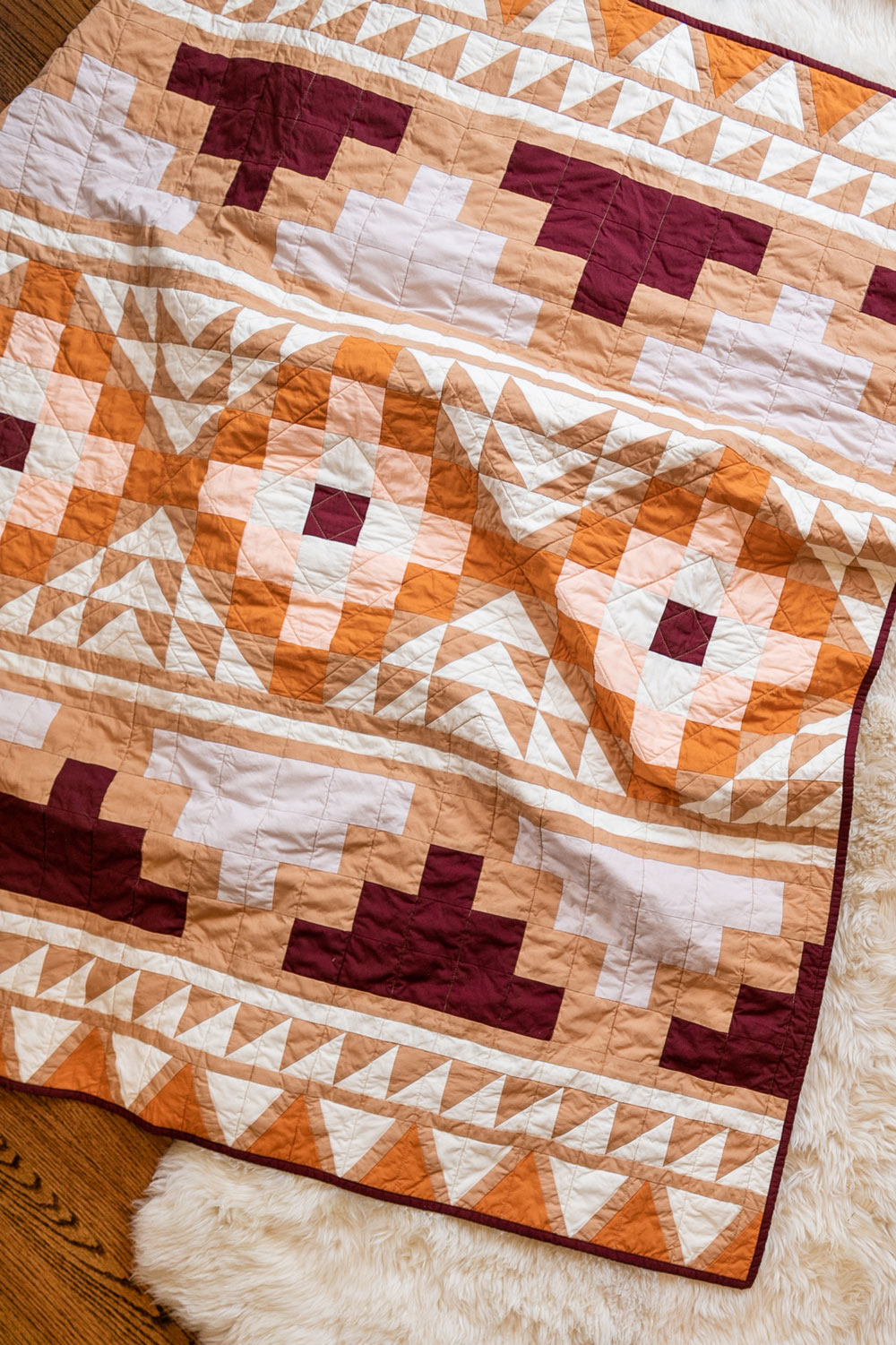
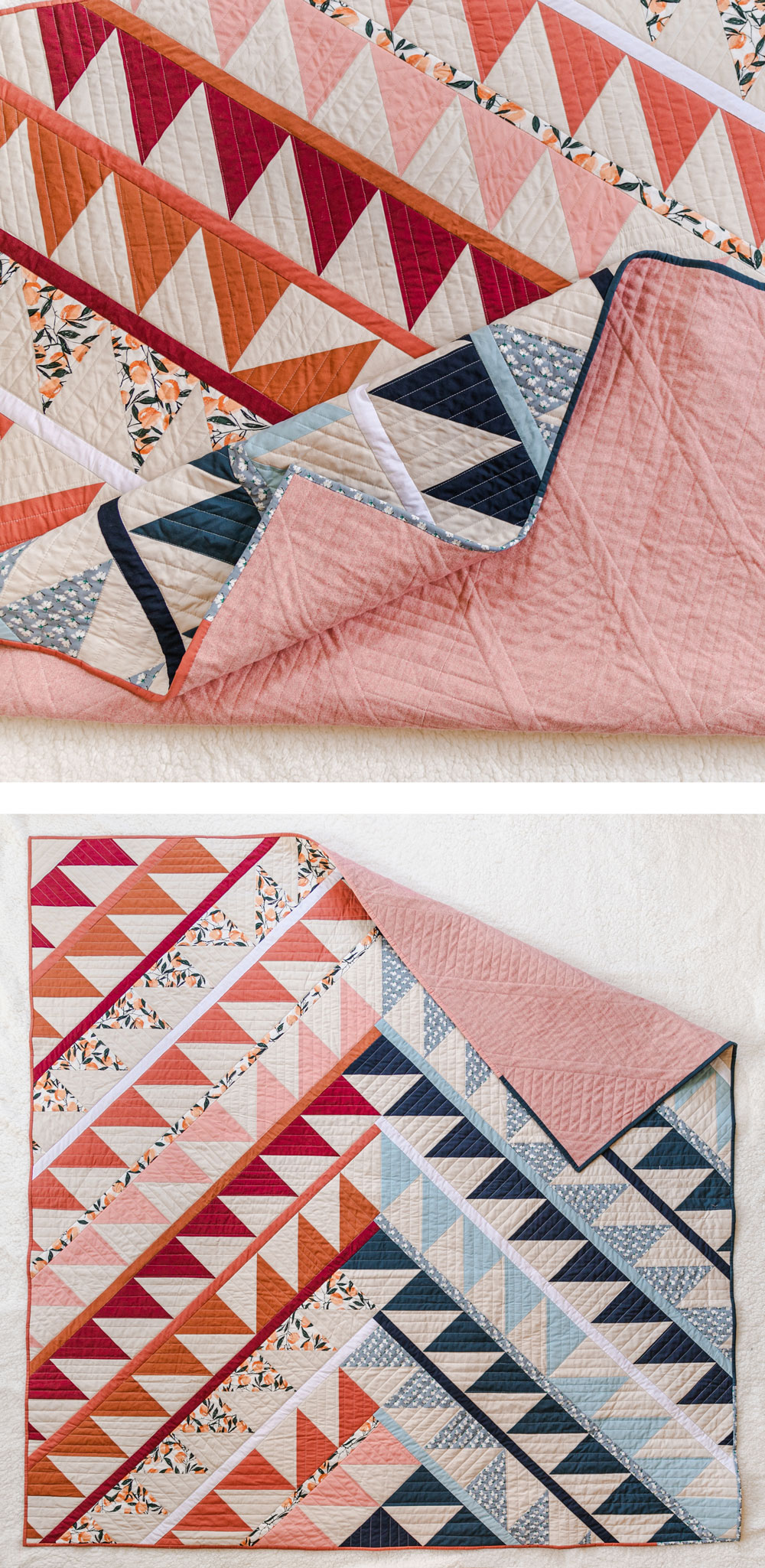
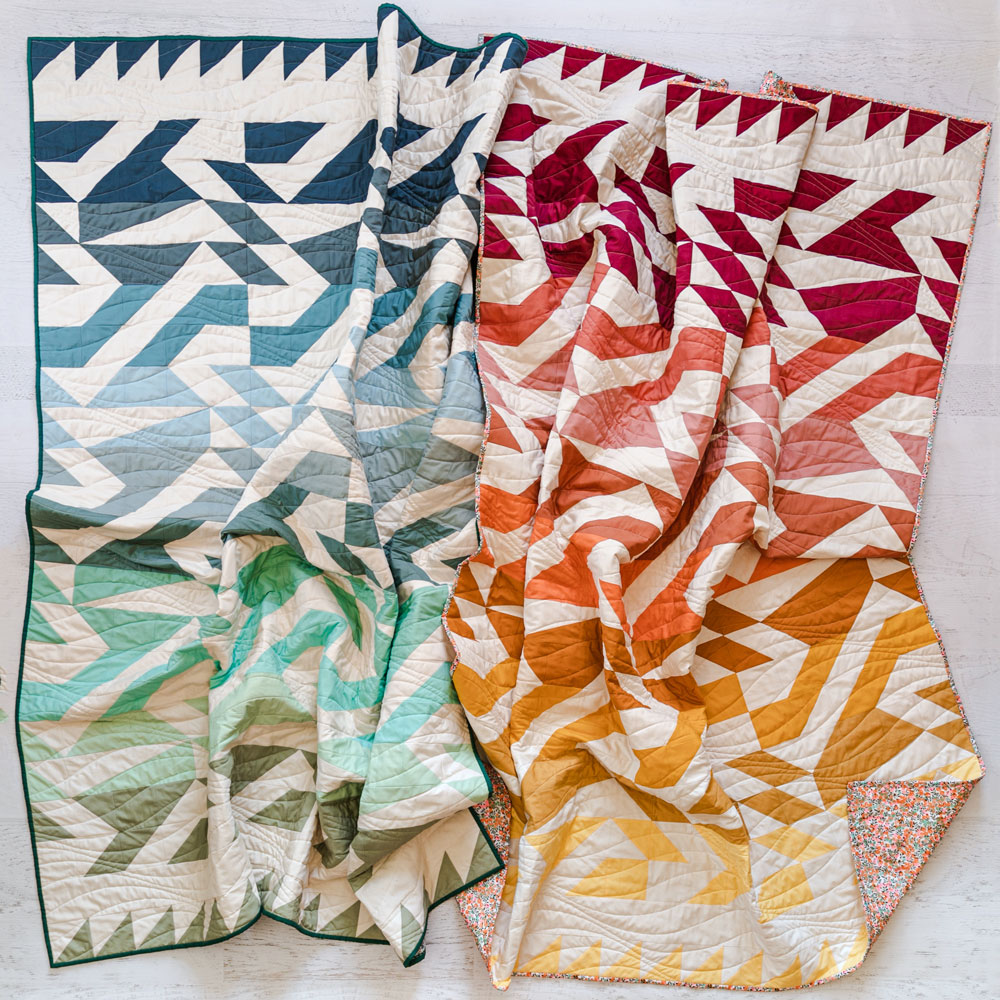
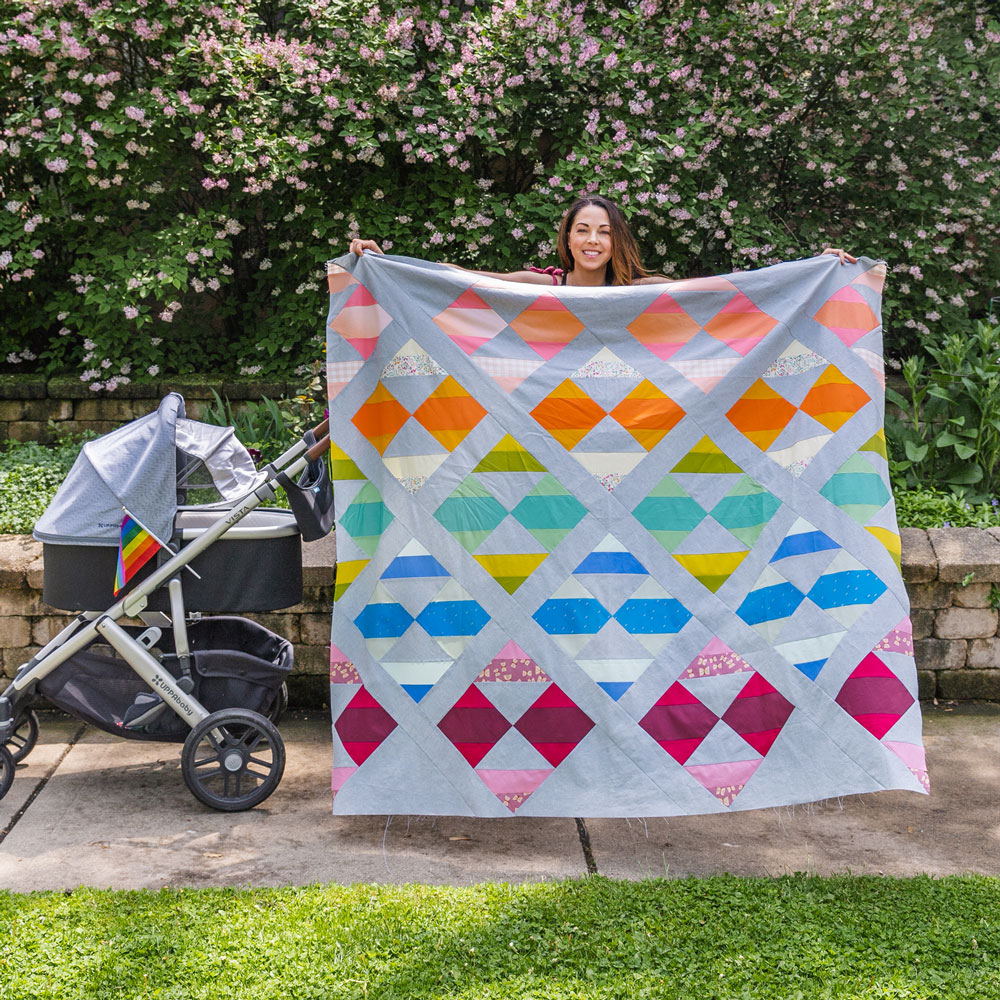
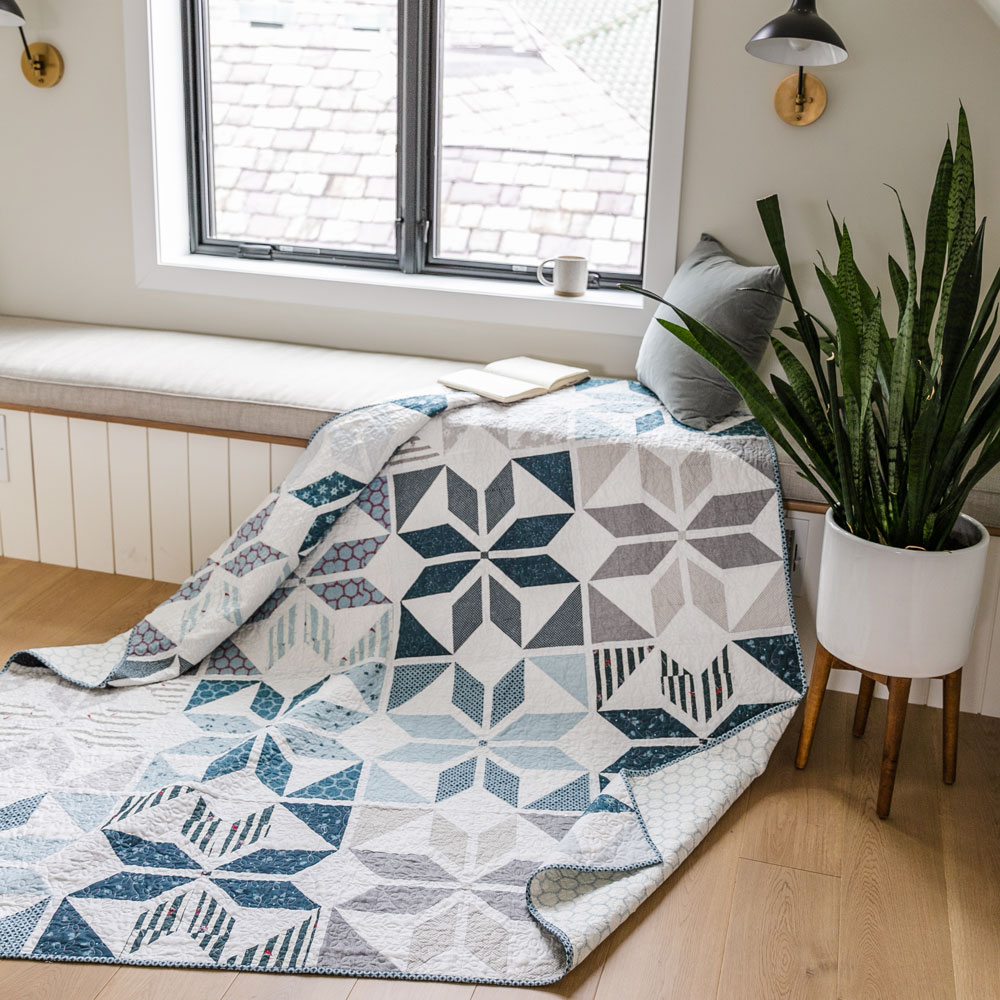
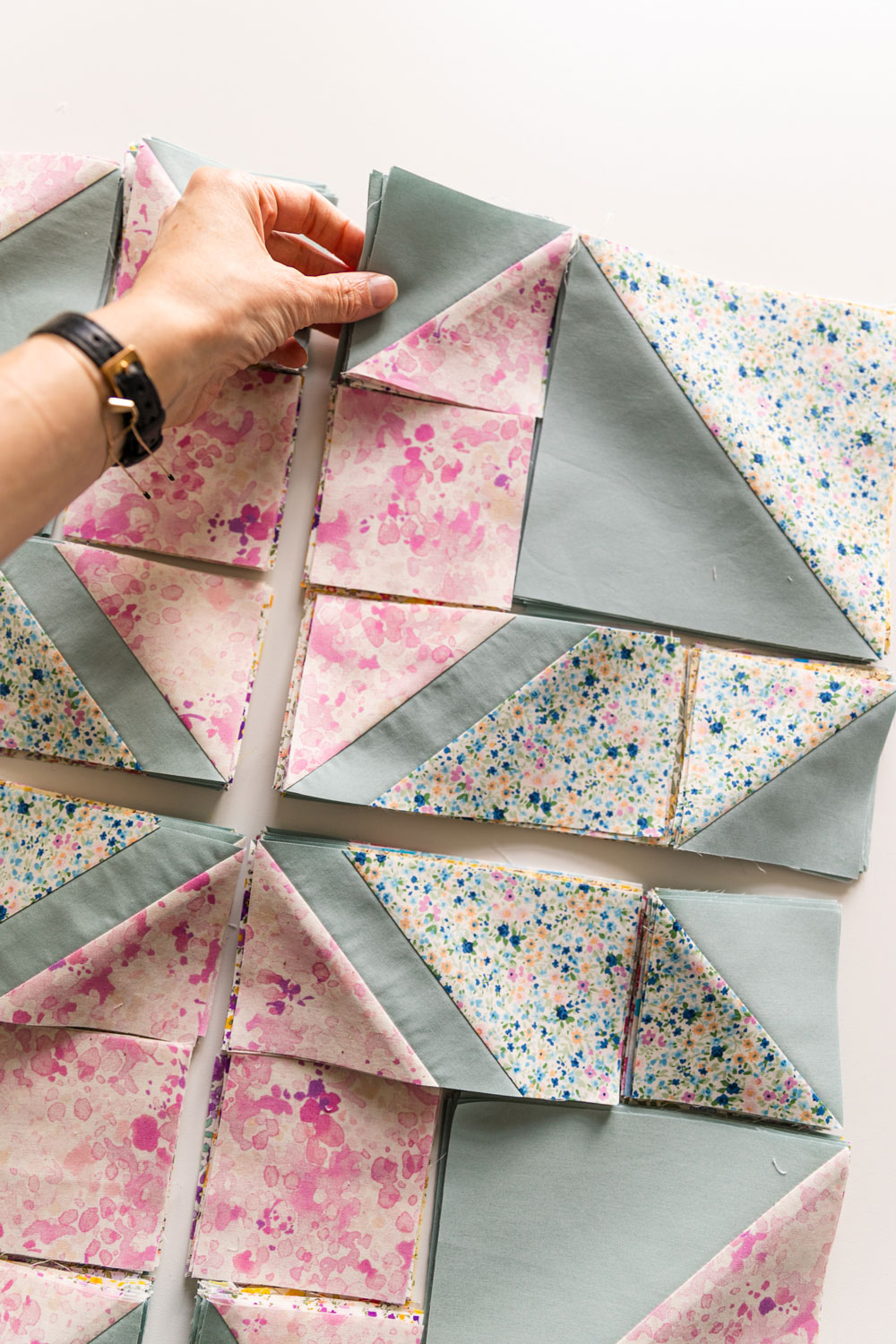

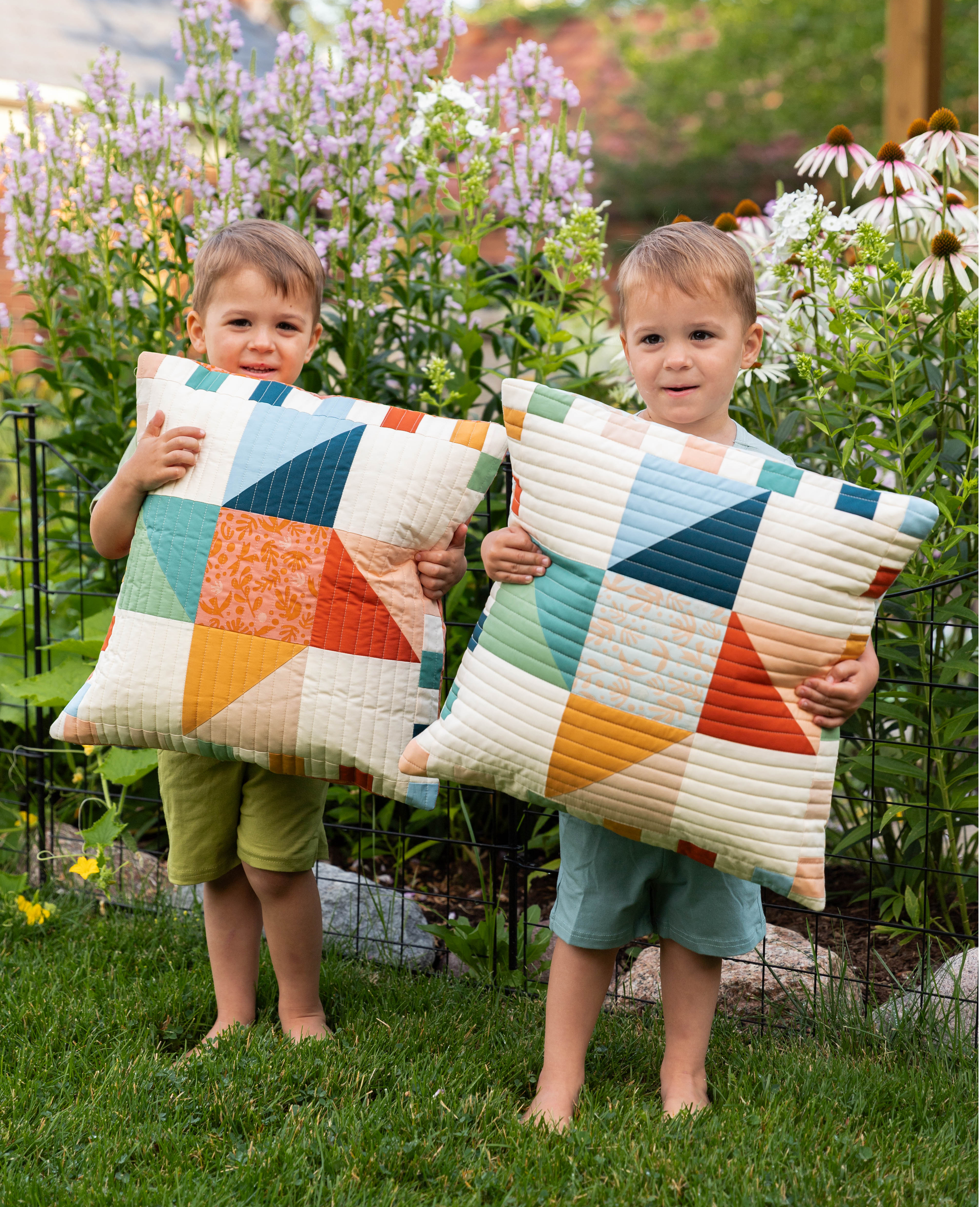

Hi. The video says 5.5″ squares will yield 8 2.5″ hst is this correct? It doesn’t seem to match the table posed above for octo hst…maybe I am not understanding? Love this way and want to try!
No, you are totally right! In the video I mention that a 5 ½” square makes 8 unfinished 2 ½” HSTs. Since then, I have changed the math so that there is a little more wiggle room in the sewing and cutting. According to the chart below (which I recommend using) a 5 ¾” square will produce 8 unfinished 2 ½” HSTs. I’m so sorry for the confusion! I have added a note and I should have clarified that from the beginning. xoxo
Thank you! I definitely need the wiggle room. Your quilts are so beautiful. I’m off to make some HSTs.
Thank you so much for this tutorial! It was so helpful and gave me enough encouragement at tackling a half triangle quilt.
Woot! You go, gurrrrl!!
I love HST because of the flexibility to create several designs. Do you have a table that shows say I want to do a baby quilt or a lap size quilt and I already have a bunch of 6″ squares cut. How many squares do i need to make a proportional quilt? I have several 6 in squares and 10 in squares that I would like to do something with but I always struggle getting a proportional sized blanket so mine are always unique. haha. 😀 What is the typical size square you cut than can be used for several designs and sizes quilts?
I’m always change’n things up, so I can’t say that I cut a specific size of square to have for future quilting. If I were in your shoes, and had a bunch of 6″ squares, I’d probably pair the lights and the darks together and use The Basic HST technique. That way the blocks won’t get too small and they will all be proportional to each other. Thanks for the comment and happy sewing!! xo
i ordered the Triangle Jitters pattern and after some head scratching I got to work. Just finished the quilt top today and I LOVE it. Am completely obsessed and already planning different fabric options. Thank you so much and I really enjoy your site. I am new to quilting and am gravitating towards a more modern look. You have given me so many great ideas and opened my imagination.
Yeah!! I’m so glad! Thanks for the sweet comment and if you have Qs along the way, feel free to shoot me an email 🙂
You just made my week with this tutorial, and the technique breakdowns. I’m a total beginner but have wanted to figure out this type of triangle cut for so long…and then I found you! Thank you! I have a niece and a nephew due in a few months and I’m going to use them as my guinea pigs!
yeah!! I’m so glad you found it helpful 🙂
thanks so much, this should make it a whole lot easier!!!!
Thanks so much for showing the three methods together! It really helped me finally “get it”.
Great info on hst and the varieties to cut; also appreciate the size charts for each method. Thank you.
Best sunset ever is in Albuquerque New Mexico. Have you been there? It’s like fire in the sky. All that fine dust from the desert kicking up into the atmosphere, I think, does something magical.
I’m making Fly Away and while I have made plenty of my half-square triangles using the 8 at a time method, after laying it out I have decided I need more in some of my fabrics. So, back to the sewing machine. I thought 4 of each would be great and I came here to look at how to make them, but I have a question. Making them 2 or 8 at a time you seam across the bias edge of the fabric, but on the 4 at a time the seam is on the straight grain, leaving the bias as the edges of the square. I know I am being super picky about that detail, but what are your thoughts on that? I know that strip piecing the squares puts the seam on the straight grain, too. I’m likely to make them 2 at a time to keep the bias stable in the seam. Just wondering what others think.
Great question! As long as you aren’t stretching the fabric a lot, you should be fine mixing bias-seamed HSTs and on-grain-seamed HSTs, especially if you sew them to each other for added stability. Using starch on your fabric is also another great way to stop excessive stretching and warping. Check out this blog post on starch for more on that – https://suzyquilts.com/starch-quilt-fabric/
Hello! I found your site via Instagram and I just LOVE it! I am making my first quilt (a baby quilt) for my baby and I love the half triangle pattern. Would you mind sharing which square size you used for the beautiful purple and lavender quilt pictured above? I figure I would probably have to go smaller for a baby quilt but wanted to know the size so I could have a frame of reference. Thanks so much!
Hi Ciara,
I’m so glad you found me 🙂 The purple quilt you mention actually is a baby quilt that I made from scrap fabric and Kona Snow yardage. I believe the finished HSTs are 4″. You could use any of the three HST methods to make those blocks based on the scraps you have on hand. Depending on the size of your scraps, you may even want to use all three methods when making one quilt. I hope that answered your question and happy sewing! xx
Thanks so much!!! I really appreciate you taking the time to respond! I’m starting this weekend. 😁
How clever is this! I am not a quilter, but recently started my 6-year old granddaughter to sewing simple block squares together to make a twin size quilt. We will have to try this. Thank you for sharing.
Thank you for this most enlightening blog. This will be my first time making a triangle quilt and after looking at your demonstration I am looking forward to it.
Yay! Good luck!
Since I’m a relatively new quilter, I’m confused about the headings on the HST tables. On the Basic and Octo the headings of the columns state FINISHED HST, but the Quad column headings state UNFINISHED HST. I’m making a quilt that uses 6 1/2″ HST, but when they are sewn into the quilt, allowing for the 1/4″ seams, they’ll end up 6″. I want to use the Octo method since this is a king-sized quilt and I need a lot of HST. If I use the Octo method, will I need to cut the HST down to 6 1/2″ or will following the table give me the 6 1/2″ unfinished block. HELP!!! I love, love, love having three different methods of making multiple HSTs.
If you want 6″ finished HSTs, according to the Octo method, you need to cut 13 3/4″ squares (this will give you 6 1/2″ HSTs unfinished. Since you are a beginner, I would recommend getting yourself a 6 1/2″ square ruler and upping the cut size by a 1/4″ (14″ square). That way you can have some wiggle room and trim them down to be exactly the size you need. I would also recommend making a test block before diving into batch sewing for a huge quilt. Good luck!
If I’m hand sewing, can I still follow the octo-awesome short cut? Or do you recommend to actually start and finish with a knot in that case. Total beginner.
Are you piecing by hand? If so, I would recommend sticking with the simple Two-at-a-Time method. I worry that with hand stitching you could lose some of those stitches if they get cut up.
Thank you so much for both question and answer! I’m about to start my second quilting project and I’m planning to use HSTs. As I’m hand sewing everything I,too, was concerned that my stitches (when piecing the initial squares together) would be compromised once I got to the cutting into 2, 4 or 8 triangles stage and also when trimming off the dog ears. I was toying with the idea of making 4 or 8 HSTs at a time, but now I’ll follow your advice and stick with two 🙏 😊
With the Octo method and machine stitching, how do you keep lost stitches / unraveling under control (after trimming)? Shorter stitches?
As long as your stitch length is about 2.5 and you are gentle when pressing your seams open, you shouldn’t experience unraveling to the point that it affects the integrity of your quilt. This post on pressing may help – https://suzyquilts.com/how-to-press-seams-in-a-quilt-with-video-tutorial/
Thank you so much! Love your website and videos – so much helpful info
Hello! I’m following your throw sized Flyaway Quilt pattern instructions and using the 8-at-a-time method on page 3, it asks for 6″ squares to make 2 1/2″ unfinished HSTs (the pink chart on page 3). However, mine are ending up 2 5/8″ instead. Am I now supposed to cut each individual square to 2 1/2″ or did I screw up my math or seam allowance?* Thank you! *knowing me, probably the latter two 🙂
You’re right on the money, DJ! I made the cut squares for that pattern slightly larger than usual so you can have some wiggle room. Now that you have all of your HSTs made, use your rotary cutter and ruler to trimmy trim. Yes, not the funnest part of the quilting process, but that’s what Netflix is for! 😉
Thanks for responding so quickly. Off to press and trim my HSTs. BBC miniseries, here I come!
Sorry to bother you with my question. I am working on the Jitters Quilt which I already plan to make again. However, when I cut 10 1/4” squares into 4 HST they measure 7” each and your chart says they should be 6 1/2” for the HST. Am I cutting them wrong! I am sewing around with a 1/4” seam. Thank you!!
Hey Tori, I’m sure you’re right on track. Let’s see, are all of your blocks 7″? This 4-at-a-time method gives you room to trim in case your blocks get wonky, but a full 1/2″ does feel like a lot. Are you using a 1/4″ seam? Either way, I suggest trimming your blocks down to 6 1/2″ unfinished so that when you sew everything together they will be 6″ finished. It’s better to have this problem than to be coming up short 😉 Check out this post for tips on trimming – https://suzyquilts.com/3-tools-to-make-the-perfect-half-square-triangle/
I’m in the same boat, but closer to 6.75″! If all blocks are the same size, would it make sense to proceed without trimming and just have slightly larger blocks? Or as a new quilter is there something I’m overlooking?
I still suggest trimming the blocks to the size needed for your pattern, or at least trimming off the dog ears.
Exactly the same thing happened to me! Glad to see this post!
The link to the sunset quilt isn’t working, it produces an error message. Can you re-post?
Thanks!!
It looks like this link is no longer working, but if you hop around on the Vacilando website, you’ll still be inspired!
Do you sell your cheat sheet math chart? I would be very interested in ordering a few.
I don’t, but you could print this one out.
Hi Suzy, I’m working on the Triangle Jitters quilt which has been super fun! I made the unadvisable mistake of using this quilt to experiment with different ways to cut HSTs and my blocks don’t line up flawlessly. Is this a challenge you’ve faced before and if so curious how you adjust for it. Is it advisable to try to trip blocks back, or sew thicker seams to make things line up – or is that a sin of quilting? Any advice / education is greatly appreciated! (& if this is already answered on your site please feel free to redirect me!)
You can mash, smash, stretch and tuck any which way as long as the two pieces are sewn together. Sometimes you gotta “cheat” a little to make all of those seams line up. 😉 Another thing I like to do is add a 1/4″ to the cut squares so that my HSTs come out large enough for me to trim them all down. That gets them all really nice and square. Good luck!
Hi Suzy,
beginner quilter here, and I just wanted to ask one thing. I downloaded the Nordic Triangles Pattern and it says to trim the HSTs to a certain size – is this because the shape might be off after the Octo-Math method, or is this just to get the sizing of the finished quilt right? I wouldn’t mind having it a bit bigger if it is the later 🙂
Thank you
Great question! Inevitably after sewing HSTs you’ll have little “dog ears” or excess triangles on two of the corners because of the seam allowance. Those will need to be trimmed off. In many cases (usually in mine, and I’m not a beginner quilter) the HSTs come out slightly different sizes and will need to be trimmed a bit so they are (relatively) uniform.
The last time I made a Nordic Triangles quilt I actually upped my cutting sizes (the squares you cut for the octo method) by 1/4″ so that I could trim all of the blocks down precisely. The way the pattern is now, the HSTs should come out as the size needed and all you need to do is trim the dog ears.
Thanks Suzy, that makes sense now 🙂
I just purchased the Triangle Jitters pattern to make a quilt for our king size bed. I think I was ambitious in thinking that I would be able to easily size-up the HST to the correct size, but I’m confused. Can you tell me what the square size should be for a king size quilt?
Well, according to this quilt sizes chart, a standard king quilt is about 110″ x 108″. The Triangle Jitters Throw is pretty close to being square in size, and that design is 9 x 10 HSTs. I would probably make the finished HSTs 12″ so that your finished quilt will be 108″ x 120″. The Basic HST method will be the easiest, since you’re working with big pieces of fabric already. Go ahead and cut your squares 13″, that will leave you a bit of wiggle room to trim, then follow the instructions for the Basic method. Good luck!
I also just bought the Triangle Jitters pattern to make a queen size quilt with one additional color and borders. If I use 8’ finished squares will it be obvious how to continue the pattern to accommodate the larger dimensions, or will I just need to wing it? Thank you.
To make a queen version, use the Throw quilt layout (9 blocks x 10 blocks). Using this sizing chart, a standard queen is approximately 90″ x 108″ (I say approximate because you can fold a quilt to fit or let it hang off the edges of a bed as long as it’s in this sizing ballpark.) If you make your HSTs 10″ finished, that will give you a finished quilt of 90″ x 100″. You can add a border at that point or, if you really want to accentuate the border, make your blocks a bit smaller.
Suzy,
I purchased the nordic triangles quilt pattern and wanted to size it to fit a queen size bed. I wasn’t sure if I could just make bigger block…if so what size based on the chart included or if I could somehow repeat the pattern since I like the size blocks originally used in the pattern.
Just curious as to the light fabric in the black and gold version of the Nordic triangles quilt? Would you be able to share what it is?
Hello! I’m so obsessed with your Nordic Quilt! Its so versatile! I’m also obsessed with the patterns used in the white and orange-yellow example picture! Do you remember where you got them or what they’re called? I’m searching everywhere! Thank you!
I sewed the size 13 3/8 squares
How large should the four squares be after cropping?
I would like the desert Valley Mosaic Quilt but in a twin size. What are the measurements for this pattern? I know it says it is a throw. Has anyone made it a twin?
Hi Connie! Here’s a link to the Mosaic quilt pattern, which is only available in one size and finishes at 52 1/2″ x 61. If you’d like to make any Suzy Quilts pattern larger, we recommend adding borders until it reaches your desired size! Enjoy making your quilt! https://suzyquilts.com/shop/mosaic-quilt-pattern-download/
Is there a link to print your Half Square Triangles Cheat Sheets by themselves, apart from the article?
I’m glad you like this cheat sheet! You can either save the JPG and print it that way, or you can right click the image, open it in a new window, and then print that web page.
Suzy – Could you please provide link to cheat sheet. I must be missing it. Thanks and love your sight. MA
Hi Mary Anne! You can find the cheat sheet towards the top of this blog post. Check under the heading “Half Square Triangles Tutorial: Cheat Sheet” and you’ll see a graphic that shows the math cheat sheet for 2, 4, and 8 at a time HSTs 🙂
Just the teacher in me, but the title for today should say SLOWLY, not slow.
How something is done requires an adverb